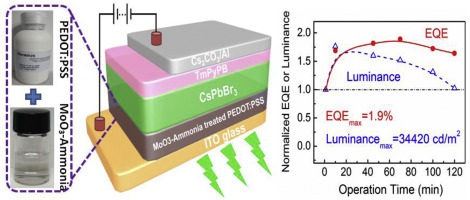Organic Electronics ( IF 3.2 ) Pub Date : 2018-10-13 , DOI: 10.1016/j.orgel.2018.10.014 Yan Meng , Mahshid Ahmadi , Xiaoyan Wu , Tianfei Xu , Long Xu , Zuhong Xiong , Ping Chen

|
Compared to organic-inorganic halide perovskites (e.g., MAPbBr3 and FAPbBr3), all-inorganic CsPbBr3 perovskite has shown to be a more promising candidate for application in light-emitting diodes (LEDs) due to higher photoluminescence quantum efficiency and thermal stability. Yet, the external quantum efficiency (EQE) of polycrystalline (3D) CsPbBr3 based PeLEDs needs further improvement. The low efficiency was attributed to severe luminescence quenching at PEDOT:PSS (Poly-(3,4-ethylenedioxythiophene):poly(styrenesulfonate))/CsPbBr3 interface arising from (i) interfacial energy barrier between PEDOT:PSS and CsPbBr3 layer, (ii) poor crystallization and large pinholes in perovskite film, and (iii) indium tin oxide (ITO) anode etching due to PEDOT:PSS acidity. Therefore, it is necessary to address all these problems simultaneously to reduce the luminescence quenching and to improve device efficiency. Here, we introduce a feasible approach to modify the PEDOT:PSS layer in order to reduce the luminescence quenching at PEDOT:PSS/CsPbBr3 interface. In this modification, PEDOT:PSS is mixed with a MoO3 ammonia solution at desired volume ratios. Our studies demonstrate that upon this treatment, not only hole injection and crystallization of perovskite film are improved but also ITO is protected from etching by the acidic nature of PEDOT:PSS. This modification result in a high performance all inorganic CsPbBr3 LED with a maximum luminance of ∼34420 cd/m2 and a current efficiency of ∼7.30 cd/A. In addition, our state-of-the-art perovskite LEDs (PeLEDs) exhibit no degradation after 2 h of continuous operation, representing a stable PeLEDs based on one-step solution processed polycrystalline CsPbBr3.
中文翻译:

高性能和稳定的全无机钙钛矿发光二极管,可减少PEDOT:PSS /钙钛矿界面的发光猝灭
与有机无机卤化物钙钛矿(例如MAPbBr 3和FAPbBr 3)相比,全无机CsPbBr 3钙钛矿由于具有更高的光致发光量子效率和热稳定性,已被证明是在发光二极管(LED)中应用的更有希望的候选者。 。然而,基于多晶(3D)CsPbBr 3的PeLED的外部量子效率(EQE)需要进一步提高。低效率归因于在(PEDOT:PSS和CsPbBr 3之间的界面能垒)在PEDOT:PSS(聚((3,4-乙撑二氧噻吩):聚(苯乙烯磺酸盐))/ CsPbBr 3界面处严重的发光猝灭层;(ii)钙钛矿薄膜中的结晶性差且针孔大;以及(iii)由于PEDOT:PSS酸性而引起的铟锡氧化物(ITO)阳极蚀刻。因此,必须同时解决所有这些问题,以减少发光猝灭并提高器件效率。在这里,我们介绍了一种可行的方法来修改PEDOT:PSS层,以减少PEDOT:PSS / CsPbBr 3界面处的发光猝灭。在此修改中,PEDOT:PSS与MoO 3混合所需体积比的氨溶液。我们的研究表明,通过这种处理,不仅钙钛矿薄膜的空穴注入和结晶得到改善,而且PEDOT:PSS的酸性还可以保护ITO免受腐蚀。这种修改导致高性能的全无机CsPbBr 3 LED的最大亮度约为34420 cd / m 2,电流效率约为7.30 cd / A。此外,我们最先进的钙钛矿LED(PeLED)在连续运行2小时后没有降解,表示基于一步法溶液处理的多晶CsPbBr 3的稳定PeLED 。


























 京公网安备 11010802027423号
京公网安备 11010802027423号